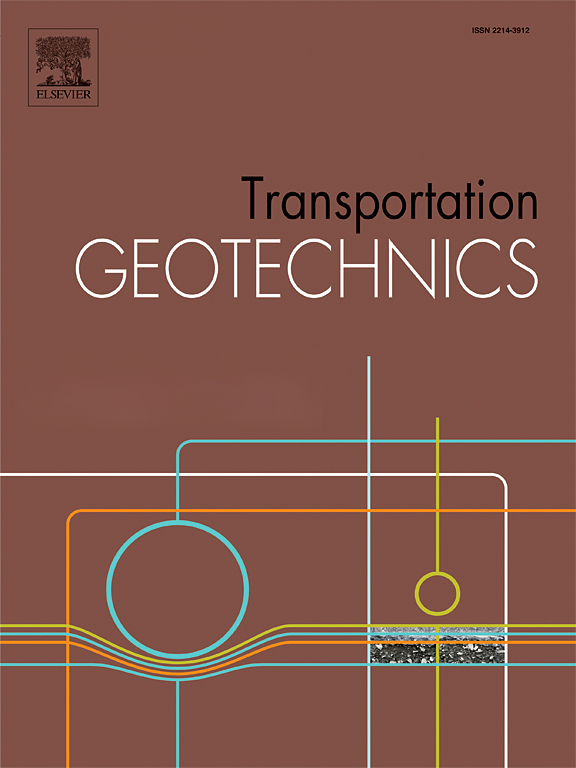地震荷载下斜坡内部演变过程研究:透明土壤试验和振动台试验的启示
IF 5.5
2区 工程技术
Q1 ENGINEERING, CIVIL
引用次数: 0
摘要
地震是引发斜坡失稳的主要因素,并对交通构成严重威胁。然而,目前对地震荷载下边坡内部变形的研究仍然有限。为了研究不同地震荷载对边坡演变过程和破坏模式的影响,本研究提出了一种结合透明土材料和振动台试验的新型实验。利用自行设计的振动台系统,施加了振幅为 0.10 g、0.15 g 和 0.20 g,频率为 3 Hz、5 Hz 和 8 Hz 的正弦波。基于粒子图像测速仪(PIV)技术和非侵入式监测技术,分析了斜坡的位移和速度等值线图、全场平均位移和破坏机理。结果表明,随着振动的持续,边坡从最初的浅直线滑动过渡到整体圆弧滑动,表现出明显的渐进牵引破坏模式。斜坡的演变过程可分为三个阶段:浅层低速滑动阶段、整体快速滑动阶段和整体低速滑动阶段。此外,与频率相比,地震加载的振幅对边坡变形的影响更大。这项新颖的实验为研究地震荷载作用下斜坡的内部演变过程提供了重要的启示。本文章由计算机程序翻译,如有差异,请以英文原文为准。
Investigation on internal evolution process of slope under seismic loading: insights from a transparent soil test and shaking table test
Earthquakes are a primary factor in triggering slope instability and pose a serious threat to transportation. However, current research on the internal deformation of slopes under seismic loading remains limited. To investigate the effects of different seismic loadings on the evolution process and failure mode of slopes, a novel experiment combining transparent soil materials and shaking table tests was proposed in this study. Using a self-designed shaking table system, sine waves with amplitudes of 0.10 g, 0.15 g, and 0.20 g and frequencies of 3 Hz, 5 Hz, and 8 Hz were applied. Based on Particle Image Velocimetry (PIV) technology and non-intrusive monitoring techniques, displacement and velocity contour maps, whole-field average displacement and failure mechanism of the slope were analyzed. The results show that, as the vibration persists, the slope transitions from initial shallow linear sliding to overall circular arc sliding, exhibiting an obvious progressive traction failure mode. The evolution process of the slope could be divided into three phases: shallow low-speed sliding phase, overall rapid sliding phase, and overall low-speed sliding phase. Furthermore, the amplitude of seismic loading has a greater influence on slope deformation compared to its frequency. This novel experiment offers important insights into the internal evolution process of slopes under seismic loading.
求助全文
通过发布文献求助,成功后即可免费获取论文全文。
去求助
来源期刊

Transportation Geotechnics
Social Sciences-Transportation
CiteScore
8.10
自引率
11.30%
发文量
194
审稿时长
51 days
期刊介绍:
Transportation Geotechnics is a journal dedicated to publishing high-quality, theoretical, and applied papers that cover all facets of geotechnics for transportation infrastructure such as roads, highways, railways, underground railways, airfields, and waterways. The journal places a special emphasis on case studies that present original work relevant to the sustainable construction of transportation infrastructure. The scope of topics it addresses includes the geotechnical properties of geomaterials for sustainable and rational design and construction, the behavior of compacted and stabilized geomaterials, the use of geosynthetics and reinforcement in constructed layers and interlayers, ground improvement and slope stability for transportation infrastructures, compaction technology and management, maintenance technology, the impact of climate, embankments for highways and high-speed trains, transition zones, dredging, underwater geotechnics for infrastructure purposes, and the modeling of multi-layered structures and supporting ground under dynamic and repeated loads.
 求助内容:
求助内容: 应助结果提醒方式:
应助结果提醒方式:


